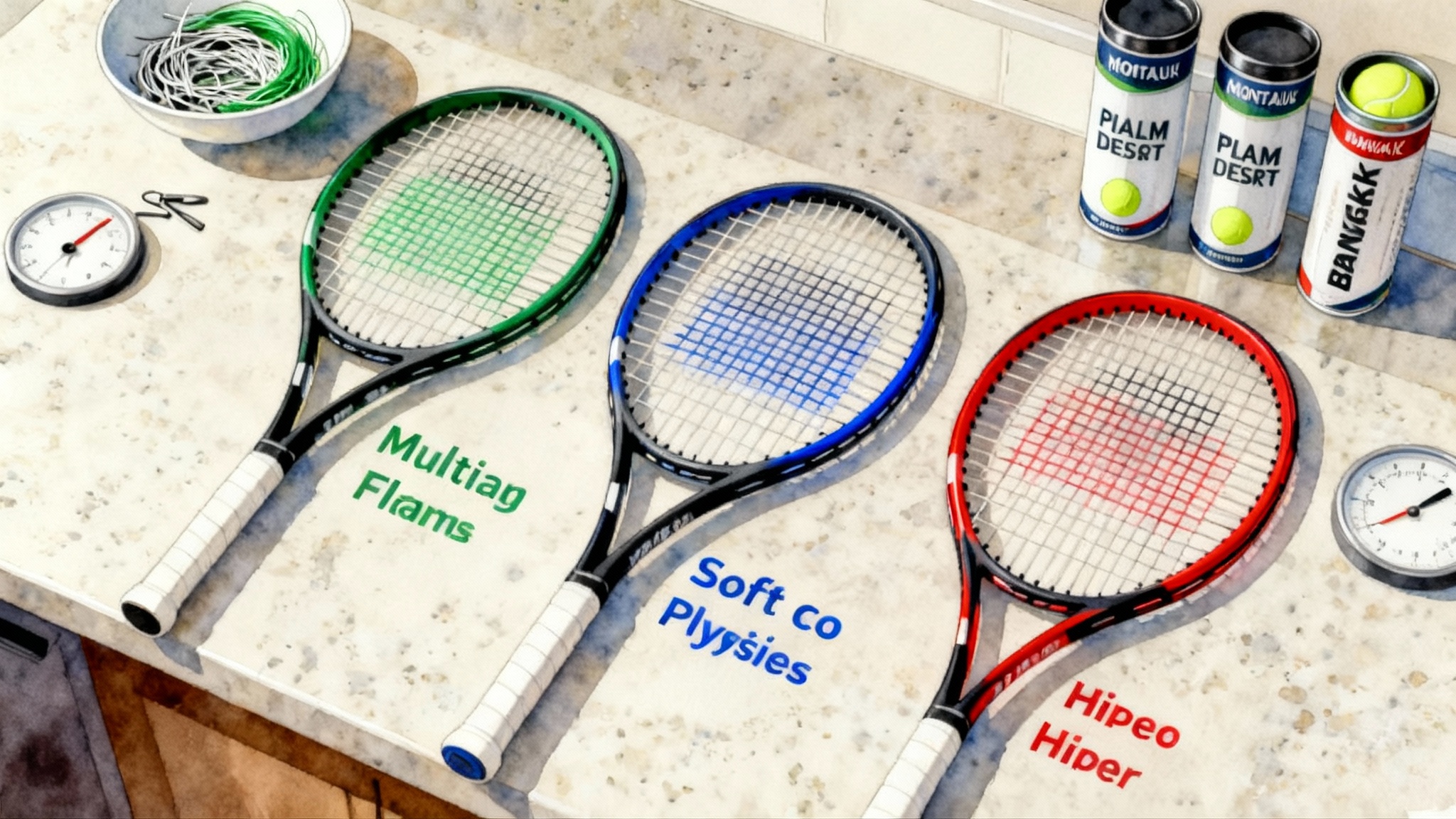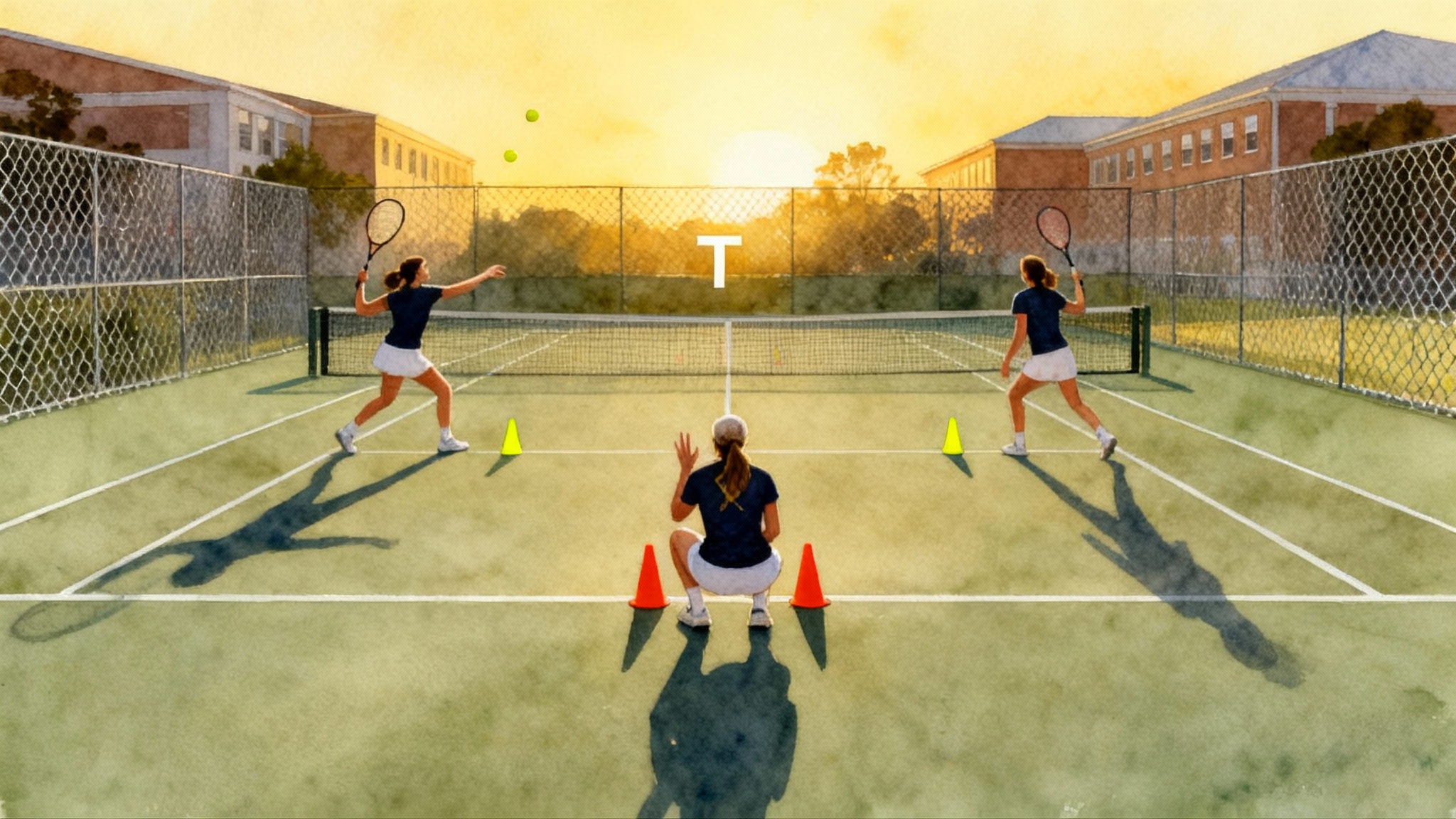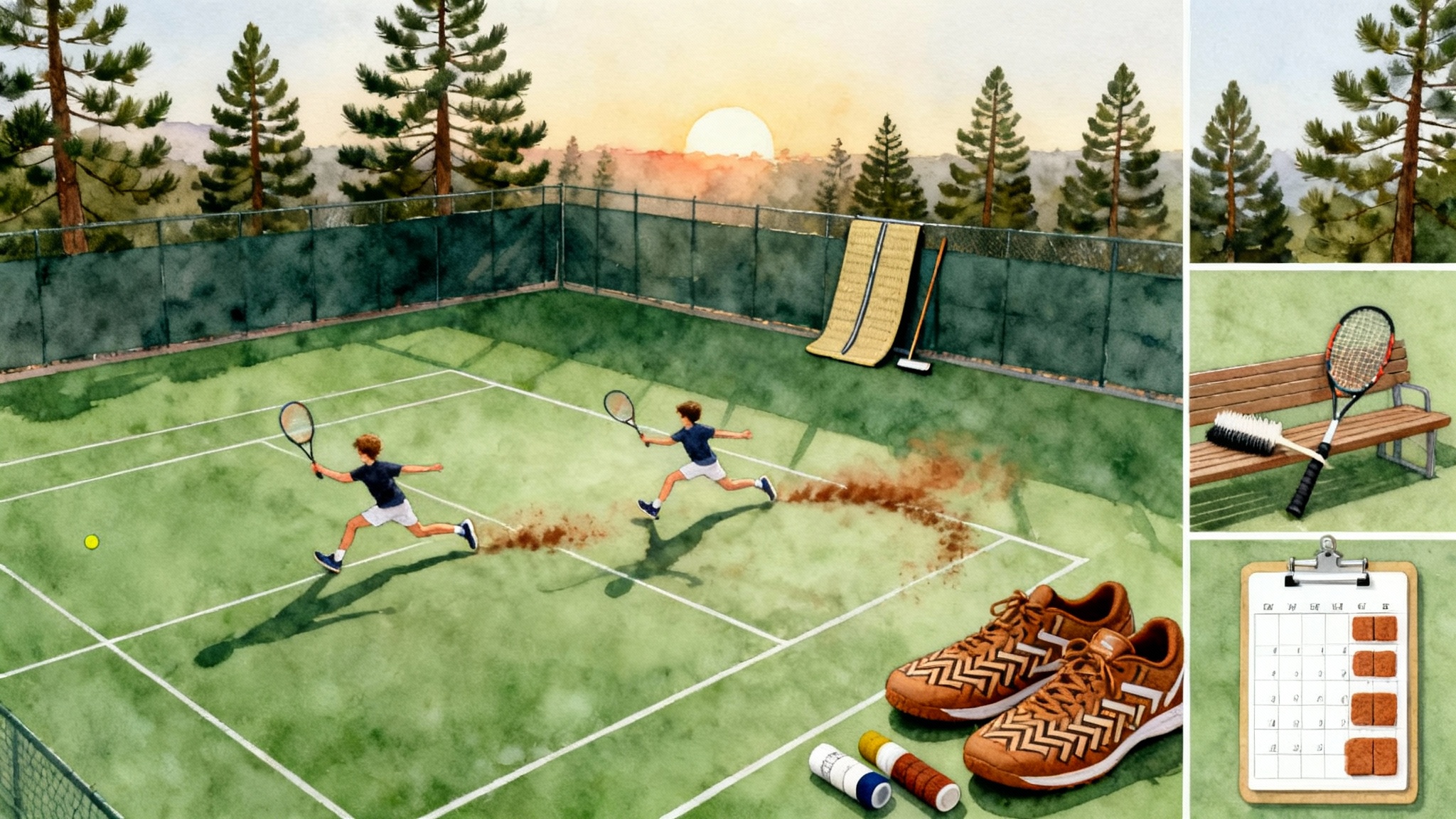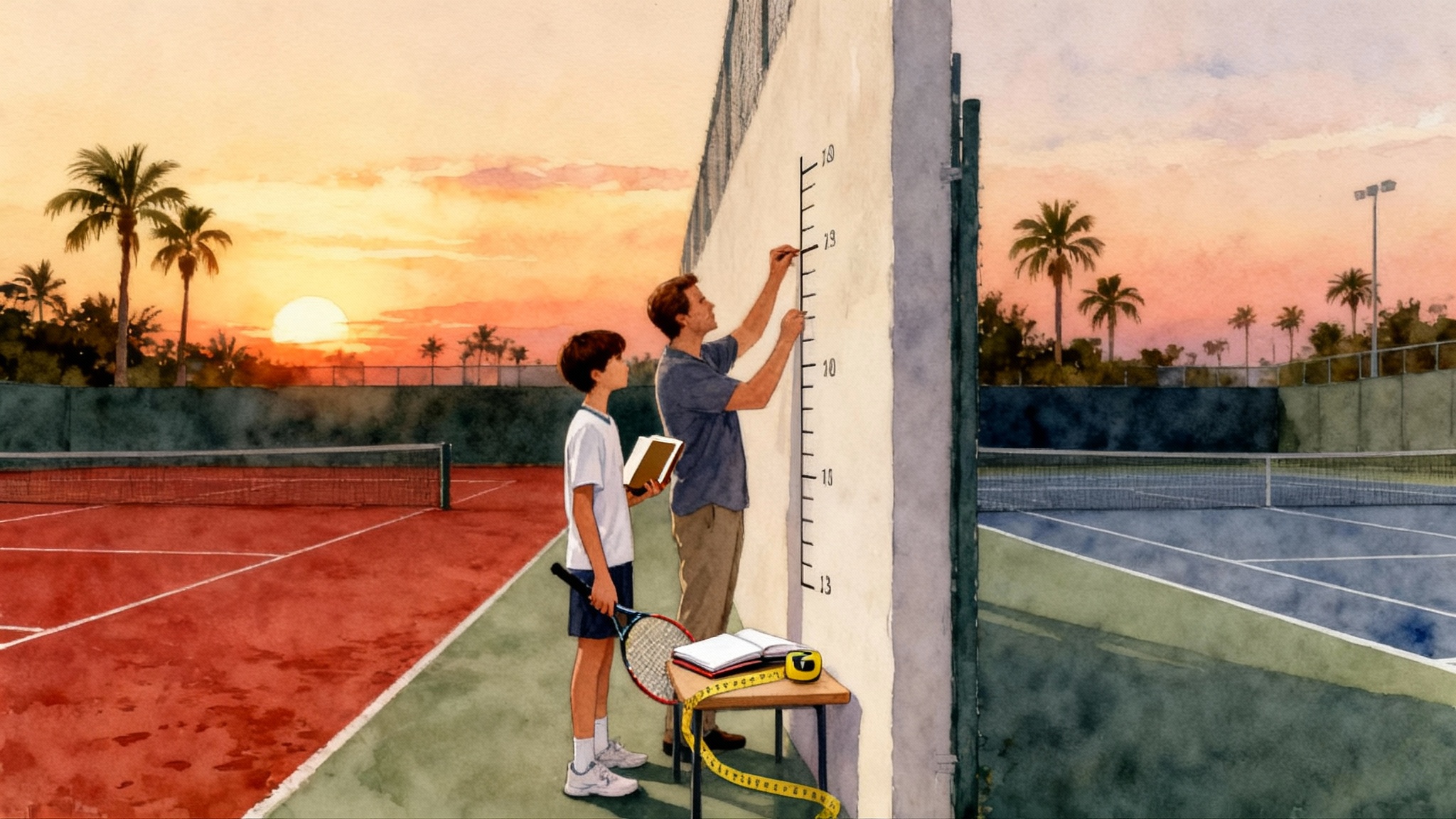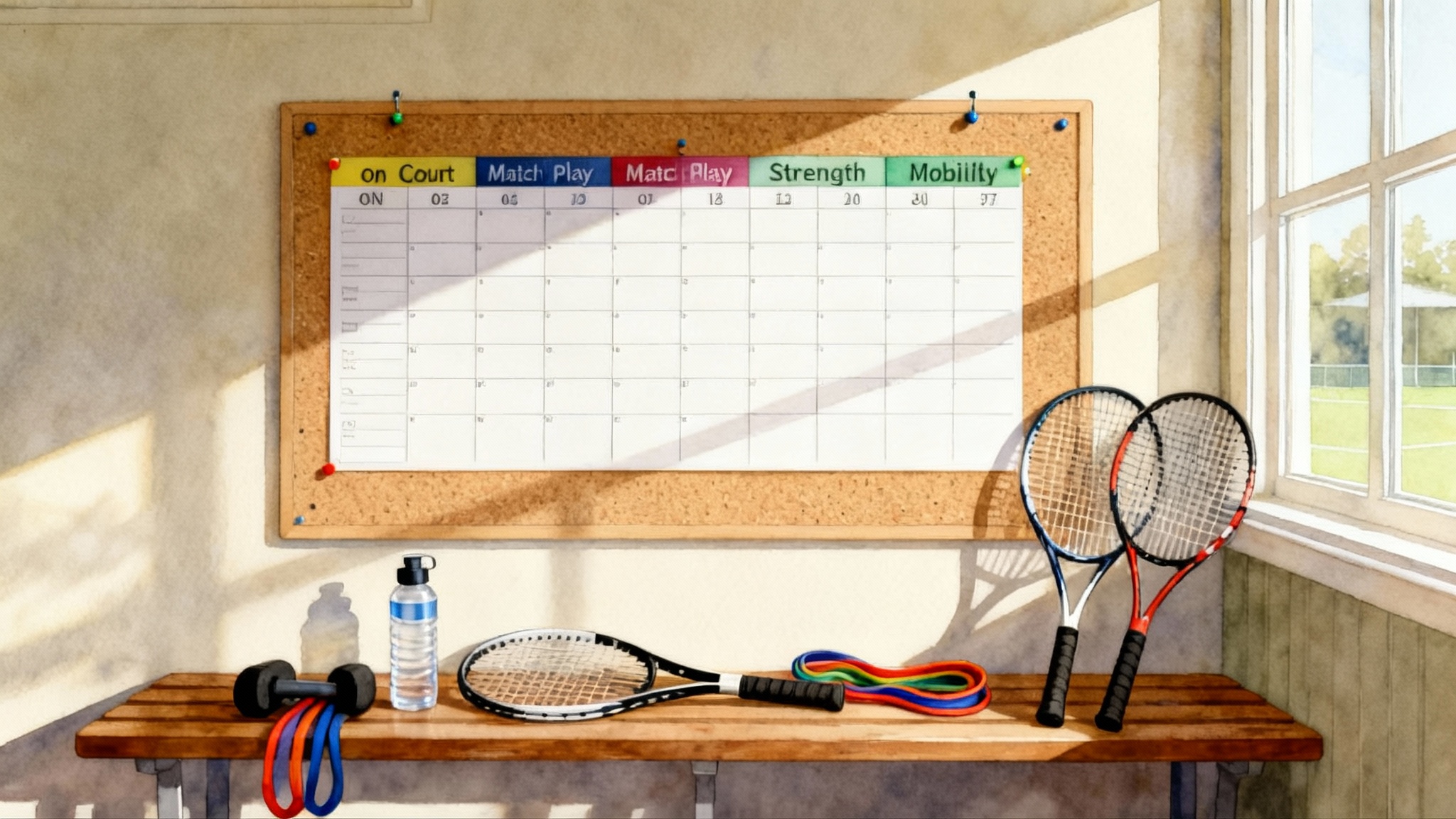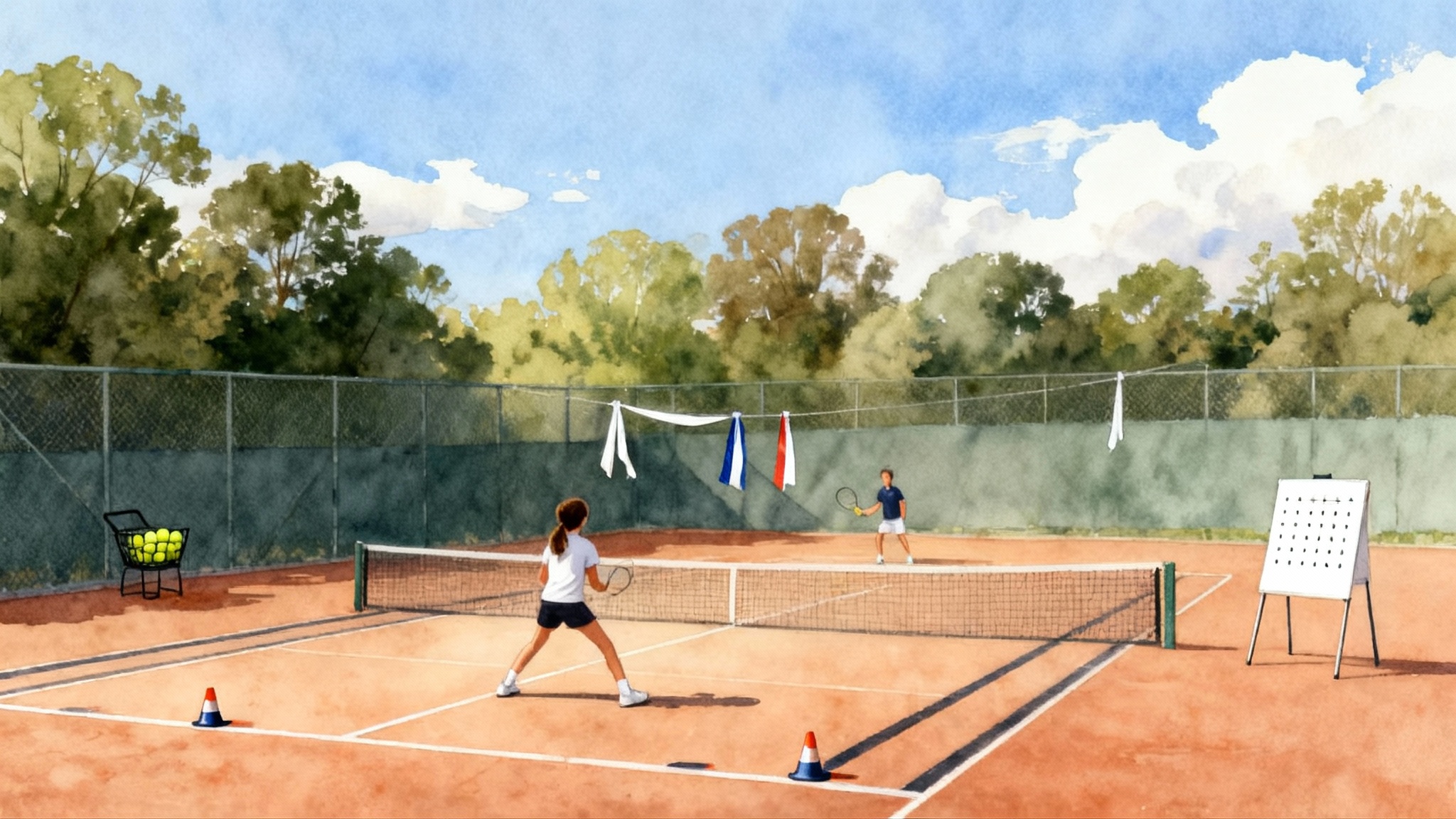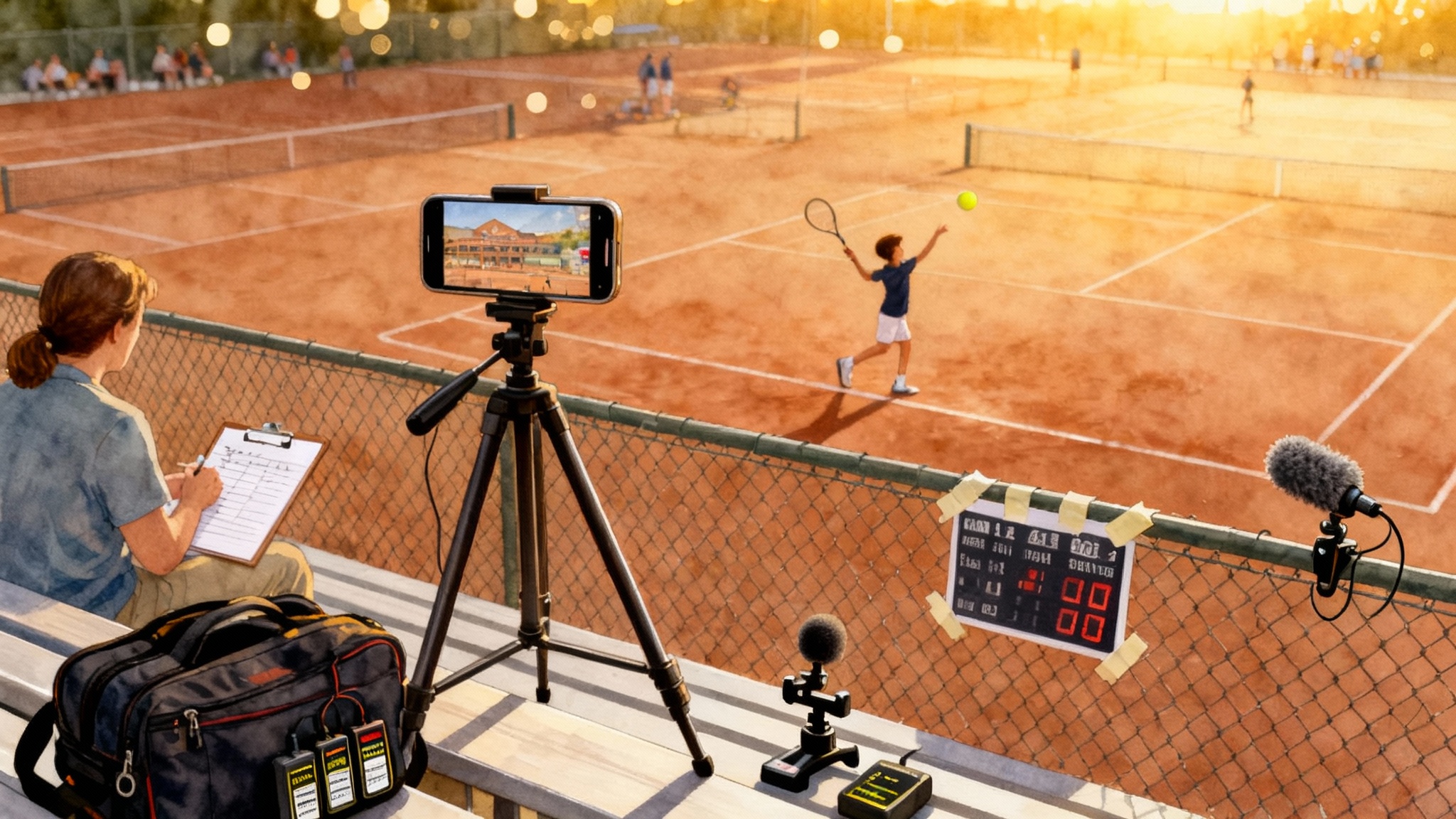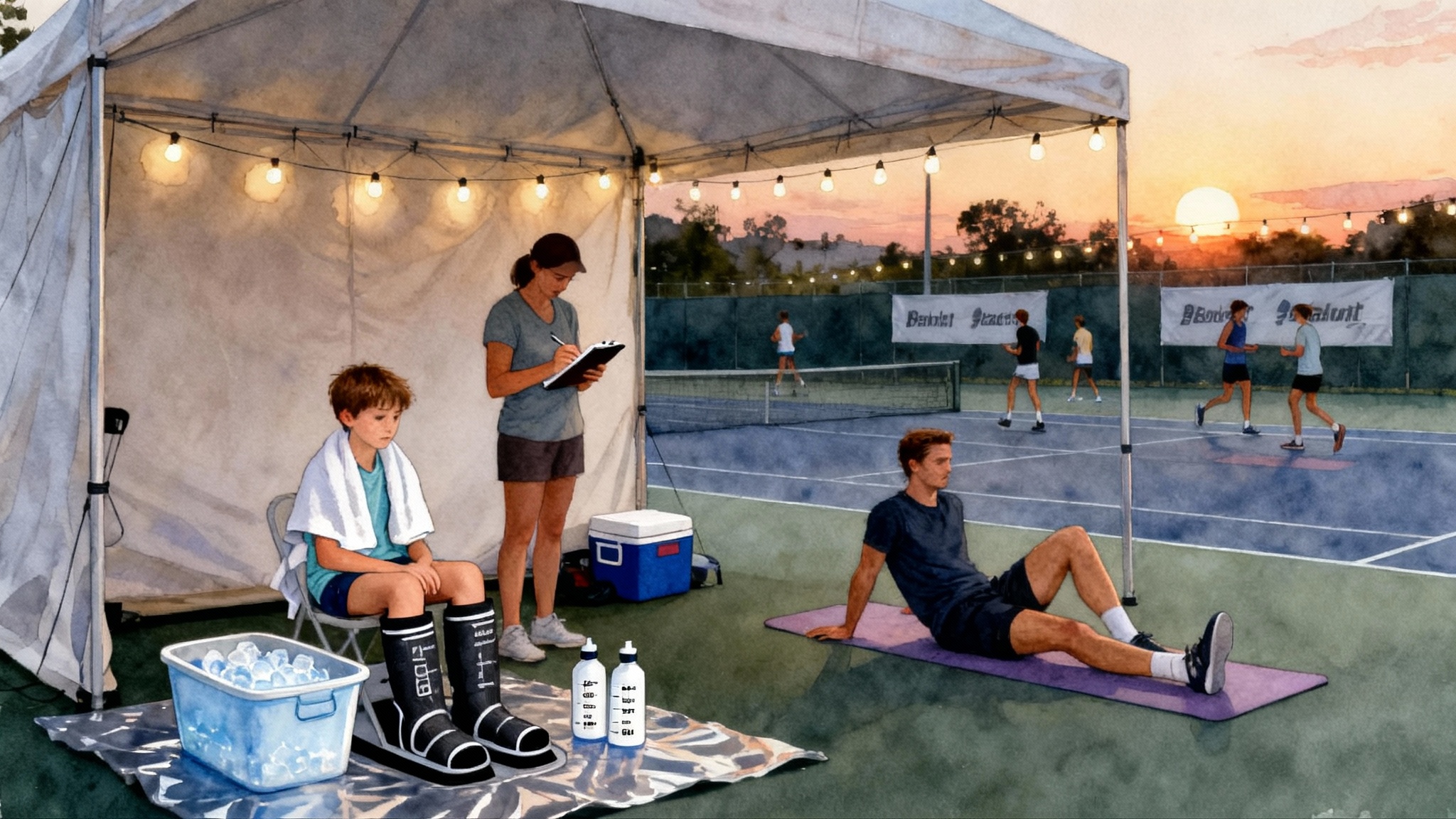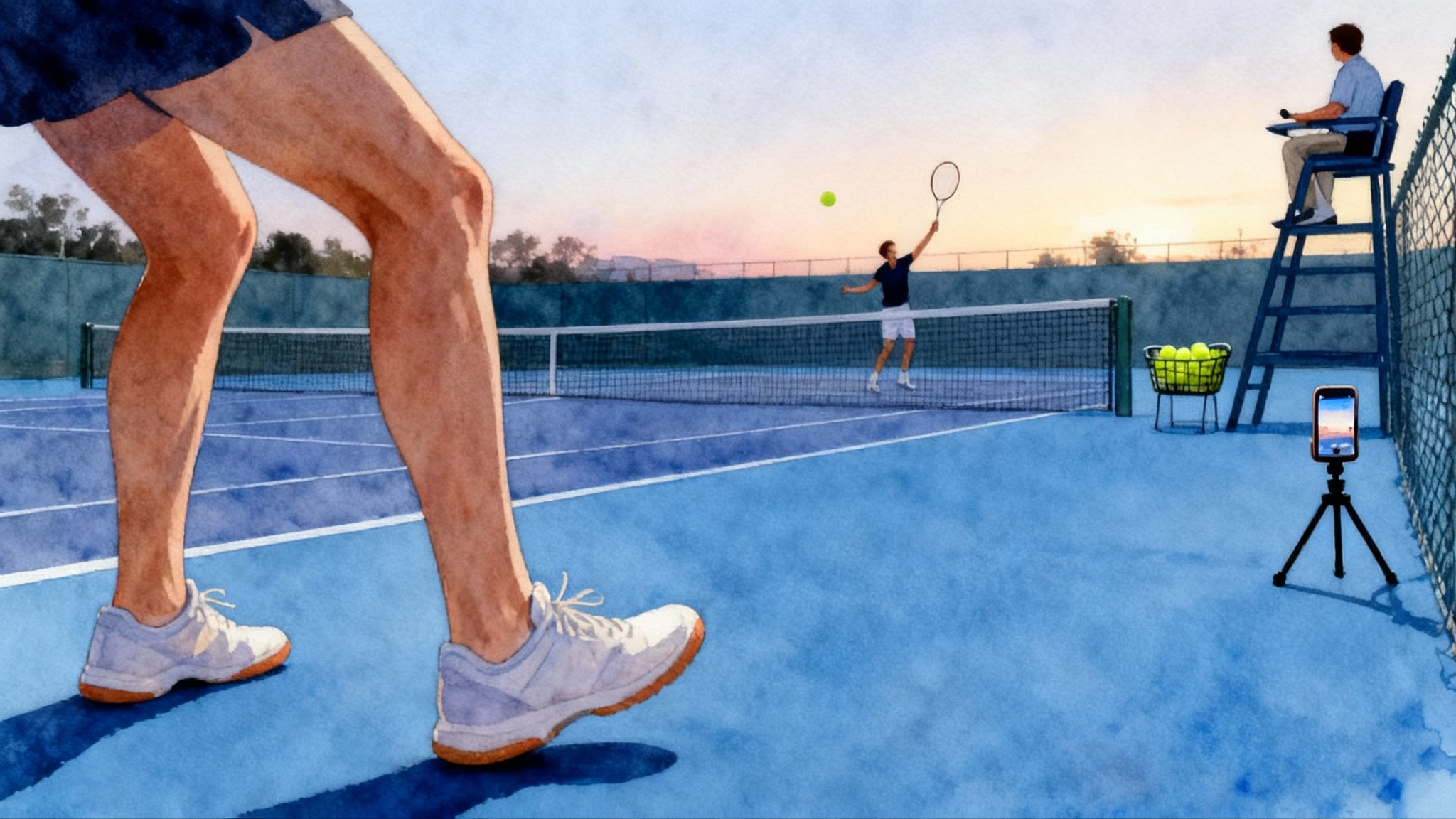Heat and Air Quality Smart Tennis: 2025 Hydration Guide
A practical, science-based plan for training and competing in summer heat and wildfire haze. Hydration and sodium targets by bodyweight, decision thresholds, acclimation, cooling, timelines, templates, and case studies in Arizona.
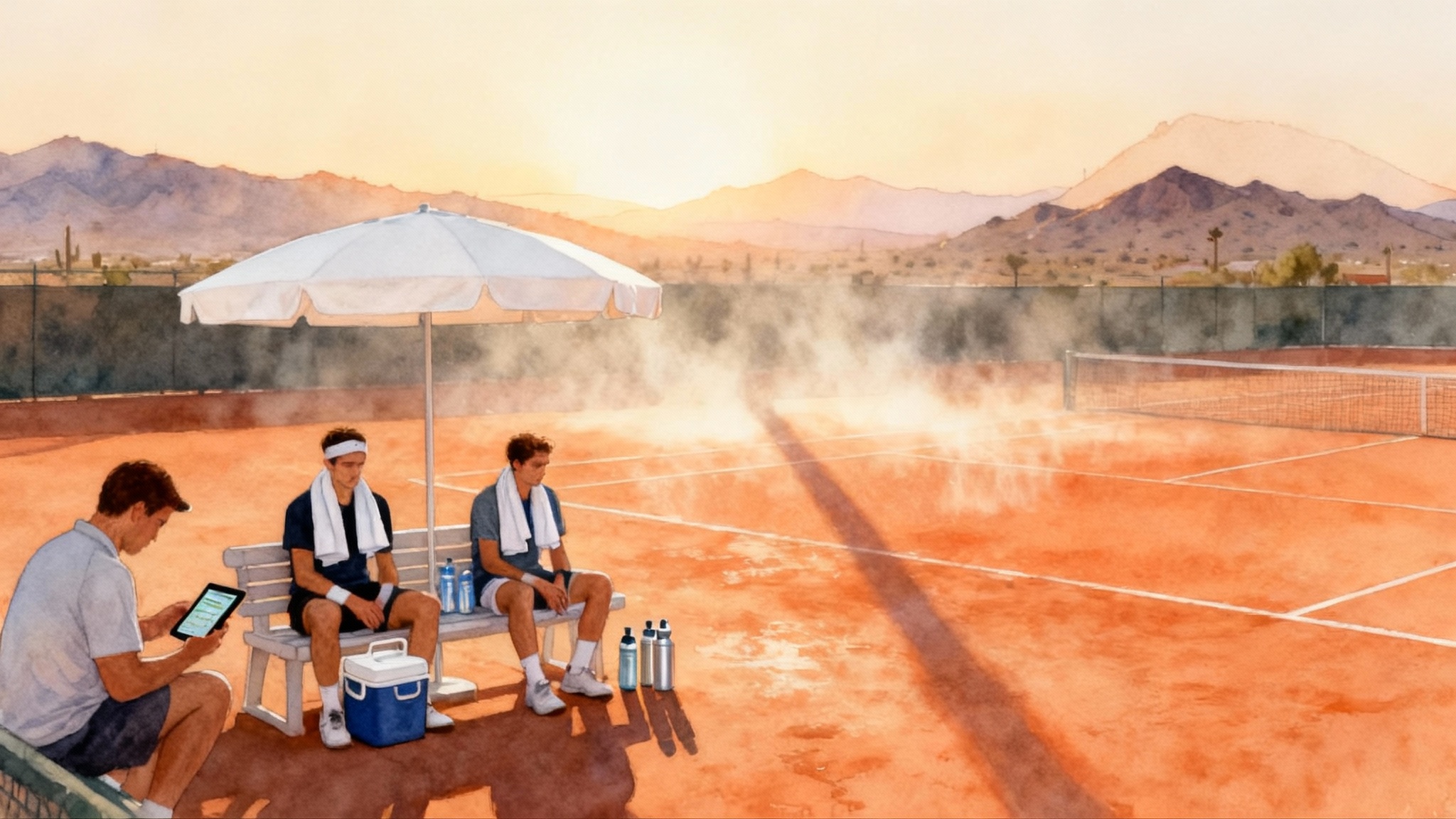
Why heat and air quality planning matters in 2025
Hotter summers, longer wildfire seasons, and packed tournament calendars now collide in ways that affect how juniors and adults train, recover, and compete. Performance drops well before you feel faint. Mistimed hydration or a poor schedule can turn a winnable third set into cramping, dizziness, or a medical timeout. The fix is not guesswork. It is a set of clear numbers, time windows, and routines you can follow every week.
This guide gives you bodyweight-based hydration and sodium targets, Heat Index and Air Quality Index decision thresholds, a 7 to 14 day acclimation plan, pre and post cooling protocols, sample weekly templates for hot markets, and tournament-day timelines. We also include red flag symptoms and when to move indoors or reschedule. Where thresholds matter, we reference the NWS Heat Index categories and the EPA Air Quality Index guide.
Quick decision rules: Heat Index and AQI
Use the stricter of the two readings at your location. Check both two hours before play and again 15 minutes before warmup.
- Heat Index below 90: Full sessions allowed. Add extra water at changeovers and shade when possible.
- Heat Index 90 to 99: Shorten drills and games to 10 to 15 minute blocks with 5 minute cooling breaks each block. Junior matches should avoid start times from 12 p.m. to 4 p.m. unless shade and ice towels are guaranteed.
- Heat Index 100 to 104: No fitness testing or maximal conditioning. Limit continuous hitting to 8 to 10 minutes, then cool. Use ice towels and a cooling station. Consider indoor courts for juniors and masters athletes.
- Heat Index 105 or higher: Move indoors or reschedule.
For air quality, use the United States Air Quality Index:
- AQI 0 to 100: Normal sessions for most players. Asthma plans in place. Hydrate as usual.
- AQI 101 to 150: Indoors for sensitive athletes, especially juniors with asthma or allergies. Outdoors only for light to moderate work capped at 60 minutes.
- AQI 151 to 200: Move indoors or cancel outdoor practices and matches.
- AQI above 200: Cancel outdoor tennis.
Combined rule: if either Heat Index or AQI exceeds its threshold, follow the stricter action. For example, Heat Index 95 and AQI 160 means indoor training or a new time.
Fluid and sodium targets per hour by bodyweight
Your goal is to limit body mass loss to about 2 percent or less on hot days. Real-world sweat rates vary, so start with these ranges and fine tune after a few weigh-ins.
- Under 40 kilograms: 0.3 to 0.5 liters per hour and 200 to 400 milligrams sodium per hour.
- 40 to 60 kilograms: 0.5 to 0.75 liters per hour and 300 to 500 milligrams sodium per hour.
- 60 to 80 kilograms: 0.6 to 0.9 liters per hour and 400 to 700 milligrams sodium per hour.
- 80 to 100 kilograms: 0.7 to 1.0 liters per hour and 500 to 900 milligrams sodium per hour.
- Over 100 kilograms: 0.8 to 1.2 liters per hour and 600 to 1000 milligrams sodium per hour.
How to use this on court:
- Pre-practice top off: 5 to 7 milliliters per kilogram of bodyweight 3 to 4 hours before play. Then 2 to 3 milliliters per kilogram 1 to 2 hours before if urine is still dark.
- During play: sip 150 to 250 milliliters at every changeover or every 10 minutes in drills. Chase water with a sodium source. For example, one standard sports drink serving has about 150 to 200 milligrams of sodium. A small electrolyte chew can add 100 to 300 milligrams.
- Post play: drink 1.25 to 1.5 liters per kilogram of body mass lost within two to four hours. Add sodium to hold the fluid. A practical option is a salty snack plus a sports drink.
Make it personal in one week:
- Weigh yourself in minimal clothing before and after a 90 minute hot session. Account for any fluid consumed. Each kilogram lost equals about one liter of sweat.
- If you lost more than 2 percent of your body mass, increase your during-play intake by 150 to 250 milliliters per hour and add 200 milligrams more sodium per hour next time.
- If you felt sloshy or needed to urinate during play, scale back volume by 150 milliliters per hour and keep sodium constant.
Seven to fourteen day acclimation plan
Acclimation improves sweat rate, lowers heart rate for a given workload, and pushes out the point where you feel overheated. Plan it like a ladder.
- Days 1 to 3: One session per day, 45 to 60 minutes on court in the morning. Add a 15 minute easy bike or walk in heat in the evening. Moderate intensity only. Target 0.5 liters per hour and your lower sodium range.
- Days 4 to 6: One 75 to 90 minute morning session with short drill blocks. Add 20 minutes of light conditioning in heat. Use ice towels during breaks. Maintain hydration at your mid-range.
- Days 7 to 9: Two sessions. Morning 90 minutes, evening 45 minutes of technique or serves. Introduce a few higher-intensity rallies but keep them under 8 minutes. Increase sodium to mid or upper range.
- Days 10 to 12: One hard morning session at match intensity for 60 to 75 minutes with strict cooling breaks, plus a 30 minute easy evening hit. Practice pre-cooling. Fine tune fluids based on weigh-ins.
- Days 13 to 14: Match simulation in the morning only. Do not stack a second hard session. Review symptoms, sleep, and appetite. If any red flags appear, repeat days 10 to 12 instead of progressing.
Rule of thumb: never add both duration and intensity on the same day. Add one, then hold the other steady.
Pre-cooling and post-cooling protocols
Pre-cooling, during-cooling, and post-cooling stack together. Use them as non-negotiables on days with Heat Index 90 or higher.
Pre-cooling, 30 to 45 minutes before warmup:
- Slushie drink: 300 to 500 milliliters of partially frozen sports drink or water with electrolytes. Cold beverages lower core temperature and are easy to keep down.
- Cooling vest: wear for 10 to 15 minutes while reviewing tactics.
- Ice towel to neck and forearms for 5 minutes just before hitting.
During play:
- Changeovers: sit in shade every time, even if you feel good. Ice towel to neck or between shoulder blades for 60 seconds. Drink to your hourly target range. Add 100 to 200 milligrams sodium every 20 to 30 minutes in long matches.
- Misting spray or handheld fan for 30 to 60 seconds.
- If dizziness or chills appear, stop. Move to shade, legs elevated, sip cool fluids, apply ice to neck, groin, and armpits, and reassess in 5 minutes.
Post-cooling, first 20 minutes after play:
- Cool rinse or 10 minute lukewarm shower. Very cold baths can cause shivering, which adds heat.
- Replace 1.25 to 1.5 liters per kilogram lost and include sodium.
- Snack with protein and carbohydrate within 30 minutes to restore energy and support recovery.
Sample weekly training templates for hot-weather markets
These templates reflect Phoenix summer conditions. Adjust start times earlier if courts lack shade.
Juniors, tournament block, week outline:
- Monday: 6:00 to 7:30 a.m. on-court technique and patterns. 7:30 to 7:45 cool. 7:45 to 8:15 strength indoors. Evening 7:30 to 8:15 serves and returns only.
- Tuesday: 6:00 to 7:15 a.m. live ball, then 15 minutes of points. Indoors after 8:00 a.m. Film review in the afternoon.
- Wednesday: 6:30 to 7:45 a.m. movement and stability circuits indoors. Optional 8:00 p.m. easy hit 30 to 45 minutes.
- Thursday: 6:00 to 7:45 a.m. match play set to 4 games. Cooling breaks every 15 minutes. Indoors after 8:00 a.m.
- Friday: 6:30 to 7:30 a.m. doubles formations and returns. No evening session.
- Saturday: 7:00 to 8:15 a.m. serves, returns, and first ball patterns. Short and sharp.
- Sunday: Rest and mobility indoors.
Adults, league or tournament prep, week outline:
- Monday: 6:30 to 7:45 a.m. drilling and live ball. Short footwork indoors at lunch.
- Tuesday: Rest from outdoor work. Strength indoors. Mobility at night.
- Wednesday: 6:30 to 7:45 a.m. doubles-focused plays. 8:00 p.m. optional 30 minute serve-only session.
- Thursday: Indoors only, cardio 30 minutes plus shoulder care.
- Friday: 6:30 to 7:30 a.m. singles patterns. No afternoon tennis.
- Saturday: Early match. If assigned midday, request reschedule or indoor court if Heat Index 105 or AQI above 151.
- Sunday: Recovery and family hit indoors.
Tournament-day timelines
Morning start example, 8:00 a.m. match
- 5:30 a.m.: Wake. 300 milliliters of cool electrolyte drink. Light breakfast with salt such as toast with peanut butter and a banana.
- 6:00 a.m.: Pack two liters of fluids for a two hour match. Include one bottle with electrolytes, one with water, and one spare.
- 6:15 a.m.: Apply sunscreen. Put cooling vest and two ice towels in a soft cooler.
- 6:30 a.m.: Travel while sipping 200 milliliters.
- 7:00 a.m.: Arrive. Slushie pre-cool begins. Bathroom check.
- 7:20 a.m.: Dynamic warmup in shade.
- 7:45 a.m.: Cooling vest 10 minutes. Visualize first four plays on serve and return.
- 8:00 a.m.: Match start. Drink 150 to 250 milliliters each changeover. Ice towel every other changeover.
- After match: Replace fluids based on body mass change. Light snack with sodium such as salted pretzels and a yogurt.
Midday start example, 1:00 p.m. match
- 10:00 a.m.: Early lunch with salt such as rice bowl with chicken and soy sauce.
- 10:30 a.m.: Begin slow sip strategy, 200 milliliters every 20 to 30 minutes.
- 11:45 a.m.: 10 minute nap if possible.
- 12:00 p.m.: Slushie pre-cool and cooling vest.
- 12:30 p.m.: Warm up in shaded area only.
- 12:50 p.m.: Reapply sunscreen.
- 1:00 p.m.: Match start. Consider sun sleeves and a white hat.
- If Heat Index reaches 105 or AQI hits 151 during play: request an indoor court if available or a delay.
Gear that actually helps
- Ice towels: pack two so one can chill while the other is in use.
- Insulated bottles: wide mouth to add ice easily. Two liters total capacity per expected two hour match.
- Cooling vest: reusable gel or ice insert styles that stay cold for 15 to 20 minutes.
- Slushie cup or insulated blender bottle: makes on-site slush easier.
- Shade creator: pop-up umbrella or canopy if the venue allows it.
- Lightweight sun sleeves and a white hat.
- Misting spray or handheld fan.
Red flag symptoms and stop rules
Stop play and begin active cooling if any of the following appear:
- Dizziness, headache, or confusion
- Chills or goosebumps while still hot
- Nausea or repeated cramps that do not resolve with sodium and fluids
- Hot, dry skin or no longer sweating
- Chest tightness or wheezing, especially on smoky days
If symptoms do not improve within five minutes of ice, shade, and sipping cool fluids, end the session and seek medical care. For players with asthma, follow the written action plan and move indoors immediately when AQI rises above safe levels.
Case studies and local help in Arizona
Case study 1, junior in Phoenix: A 14-year-old cramping late in singles moved from water-only to 0.6 liters per hour with 500 milligrams sodium and two 60 second ice towel breaks per set. Cramping disappeared across three weekend tournaments. Training volume stayed similar, but scheduling shifted to early mornings and evenings. If your junior needs structure like this, book a heat-smart evaluation with Phoenix Tennis Academy.
Case study 2, adult 4.0 player in Scottsdale: Afternoon league matches left a player lightheaded. We set a rule to avoid starts after 12 p.m. if Heat Index was 100 or higher, added a 12 minute pre-cool with a vest, and targeted 0.7 liters per hour with 600 milligrams sodium. Within two weeks, the player reported steady energy and no post-match headaches. To copy this approach with a coach who knows the local climate, talk with Fink Tennis Academy.
One-page checklists for parents and players
Parents of juniors
- Night before: freeze two bottles and two ice towels. Pack sodium sources such as sports drink, chews, or salted snacks.
- Morning of: confirm Heat Index and AQI. If either is in the red zone based on the thresholds above, ask for an indoor court or a new time.
- At venue: set up shade. Pre-cool with a slushie and a cooling vest.
- During play: supervise changeover routines. Encourage small sips and ice towel use even when the player says they feel fine.
- After play: weigh, rehydrate, and log what worked and what did not.
Players
- Know your target: liters and sodium per hour by your bodyweight.
- Changeover routine: sit, breathe, sip, ice towel, then tactical cue.
- Post-match: cool rinse, salty snack, and fluid replacement based on weight change.
- Respect the stop rules. If dizziness or confusion shows up, cooling comes first.
Coaches
- Set the schedule by Heat Index and AQI. Write it on the daily plan so no one argues with the weather.
- Use timed blocks with mandatory cooling. Keep an extra cooler of ice towels ready.
- Teach players to weigh and track. Adjust the next session based on the data.
- Have an indoor backup plan every day from June through September.
When to move indoors or reschedule
- Automatic indoor move: Heat Index 105 or higher, or AQI 151 or higher.
- Strongly consider indoor: Heat Index 100 to 104 for juniors, or any day with combined Heat Index above 95 and AQI above 120.
- Reschedule tournaments: back-to-back singles in the same afternoon window, or draws that push juniors into 1 p.m. to 4 p.m. slots during an excessive heat warning.
If indoor courts are not available, shorten formats. For example, play to 4 games with no ad, or run a match tiebreak instead of a full third set. For a step-by-step indoor switch, see our Indoor Tennis Transition guide.
Putting it all together
Heat and smoke are not random obstacles. Treat them as variables you plan for. Decide by numbers, not by feel. Set your schedule by Heat Index and AQI. Pre-cool before you swing. Drink on a bodyweight-based plan. Use sodium on purpose. Cool on every changeover. Track, adjust, and repeat.
Make heat-smart tennis your advantage this season.
